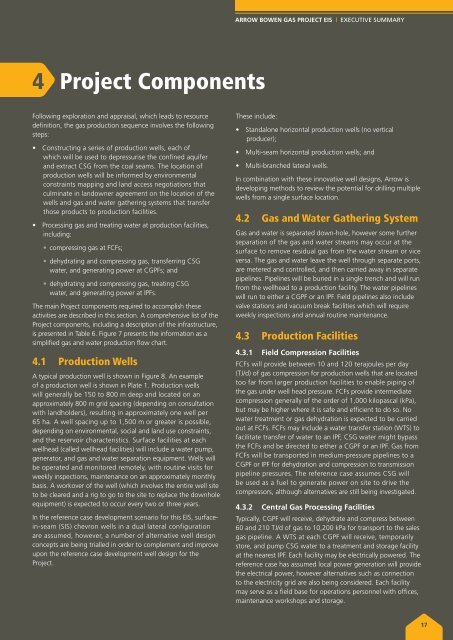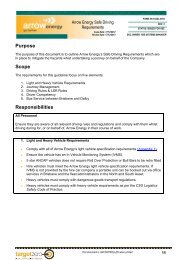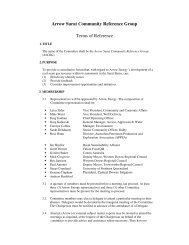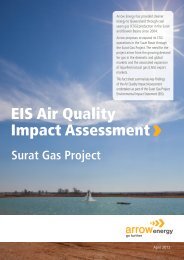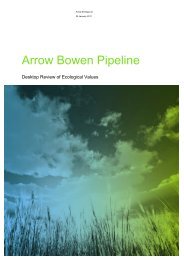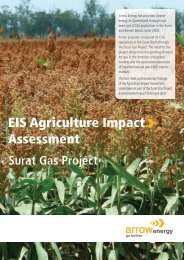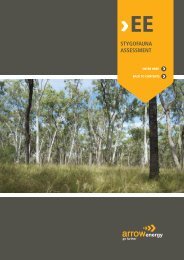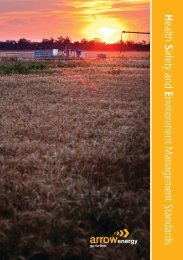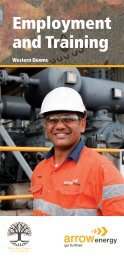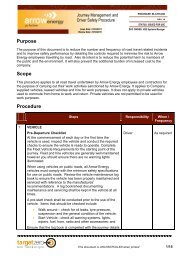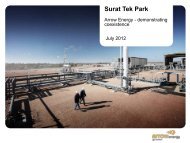Arrow Bowen GAs Project - Arrow Energy
Arrow Bowen GAs Project - Arrow Energy
Arrow Bowen GAs Project - Arrow Energy
Create successful ePaper yourself
Turn your PDF publications into a flip-book with our unique Google optimized e-Paper software.
<strong>Arrow</strong> <strong>Bowen</strong> Gas <strong>Project</strong> EIS | Executive summary<br />
4 <strong>Project</strong> Components<br />
Following exploration and appraisal, which leads to resource<br />
definition, the gas production sequence involves the following<br />
steps:<br />
• Constructing a series of production wells, each of<br />
which will be used to depressurise the confined aquifer<br />
and extract CSG from the coal seams. The location of<br />
production wells will be informed by environmental<br />
constraints mapping and land access negotiations that<br />
culminate in landowner agreement on the location of the<br />
wells and gas and water gathering systems that transfer<br />
those products to production facilities.<br />
• Processing gas and treating water at production facilities,<br />
including:<br />
• compressing gas at FCFs;<br />
• dehydrating and compressing gas, transferring CSG<br />
water, and generating power at CGPFs; and<br />
• dehydrating and compressing gas, treating CSG<br />
water, and generating power at IPFs.<br />
The main <strong>Project</strong> components required to accomplish these<br />
activities are described in this section. A comprehensive list of the<br />
<strong>Project</strong> components, including a description of the infrastructure,<br />
is presented in Table 6. Figure 7 presents the information as a<br />
simplified gas and water production flow chart.<br />
4.1 Production Wells<br />
A typical production well is shown in Figure 8. An example<br />
of a production well is shown in Plate 1. Production wells<br />
will generally be 150 to 800 m deep and located on an<br />
approximately 800 m grid spacing (depending on consultation<br />
with landholders), resulting in approximately one well per<br />
65 ha. A well spacing up to 1,500 m or greater is possible,<br />
depending on environmental, social and land use constraints,<br />
and the reservoir characteristics. Surface facilities at each<br />
wellhead (called wellhead facilities) will include a water pump,<br />
generator, and gas and water separation equipment. Wells will<br />
be operated and monitored remotely, with routine visits for<br />
weekly inspections, maintenance on an approximately monthly<br />
basis. A workover of the well (which involves the entire well site<br />
to be cleared and a rig to go to the site to replace the downhole<br />
equipment) is expected to occur every two or three years.<br />
In the reference case development scenario for this EIS, surfacein-seam<br />
(SIS) chevron wells in a dual lateral configuration<br />
are assumed, however, a number of alternative well design<br />
concepts are being trialled in order to complement and improve<br />
upon the reference case development well design for the<br />
<strong>Project</strong>.<br />
These include:<br />
• Standalone horizontal production wells (no vertical<br />
producer);<br />
• Multi-seam horizontal production wells; and<br />
• Multi-branched lateral wells.<br />
In combination with these innovative well designs, <strong>Arrow</strong> is<br />
developing methods to review the potential for drilling multiple<br />
wells from a single surface location.<br />
4.2 Gas and Water Gathering System<br />
Gas and water is separated down-hole, however some further<br />
separation of the gas and water streams may occur at the<br />
surface to remove residual gas from the water stream or vice<br />
versa. The gas and water leave the well through separate ports,<br />
are metered and controlled, and then carried away in separate<br />
pipelines. Pipelines will be buried in a single trench and will run<br />
from the wellhead to a production facility. The water pipelines<br />
will run to either a CGPF or an IPF. Field pipelines also include<br />
valve stations and vacuum break facilities which will require<br />
weekly inspections and annual routine maintenance.<br />
4.3 Production Facilities<br />
4.3.1 Field Compression Facilities<br />
FCFs will provide between 10 and 120 terajoules per day<br />
(TJ/d) of gas compression for production wells that are located<br />
too far from larger production facilities to enable piping of<br />
the gas under well head pressure. FCFs provide intermediate<br />
compression generally of the order of 1,000 kilopascal (kPa),<br />
but may be higher where it is safe and efficient to do so. No<br />
water treatment or gas dehydration is expected to be carried<br />
out at FCFs. FCFs may include a water transfer station (WTS) to<br />
facilitate transfer of water to an IPF, CSG water might bypass<br />
the FCFs and be directed to either a CGPF or an IPF. Gas from<br />
FCFs will be transported in medium-pressure pipelines to a<br />
CGPF or IPF for dehydration and compression to transmission<br />
pipeline pressures. The reference case assumes CSG will<br />
be used as a fuel to generate power on site to drive the<br />
compressors, although alternatives are still being investigated.<br />
4.3.2 Central Gas Processing Facilities<br />
Typically, CGPF will receive, dehydrate and compress between<br />
60 and 210 TJ/d of gas to 10,200 kPa for transport to the sales<br />
gas pipeline. A WTS at each CGPF will receive, temporarily<br />
store, and pump CSG water to a treatment and storage facility<br />
at the nearest IPF. Each facility may be electrically powered. The<br />
reference case has assumed local power generation will provide<br />
the electrical power, however alternatives such as connection<br />
to the electricity grid are also being considered. Each facility<br />
may serve as a field base for operations personnel with offices,<br />
maintenance workshops and storage.<br />
17


